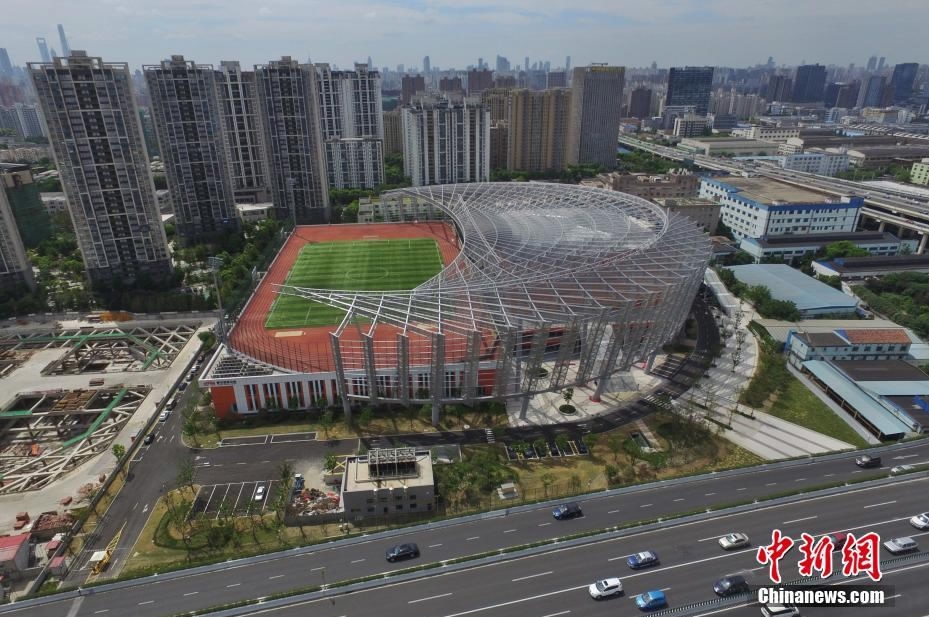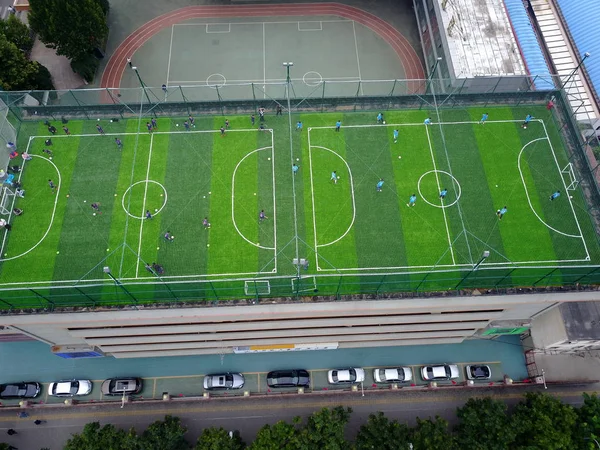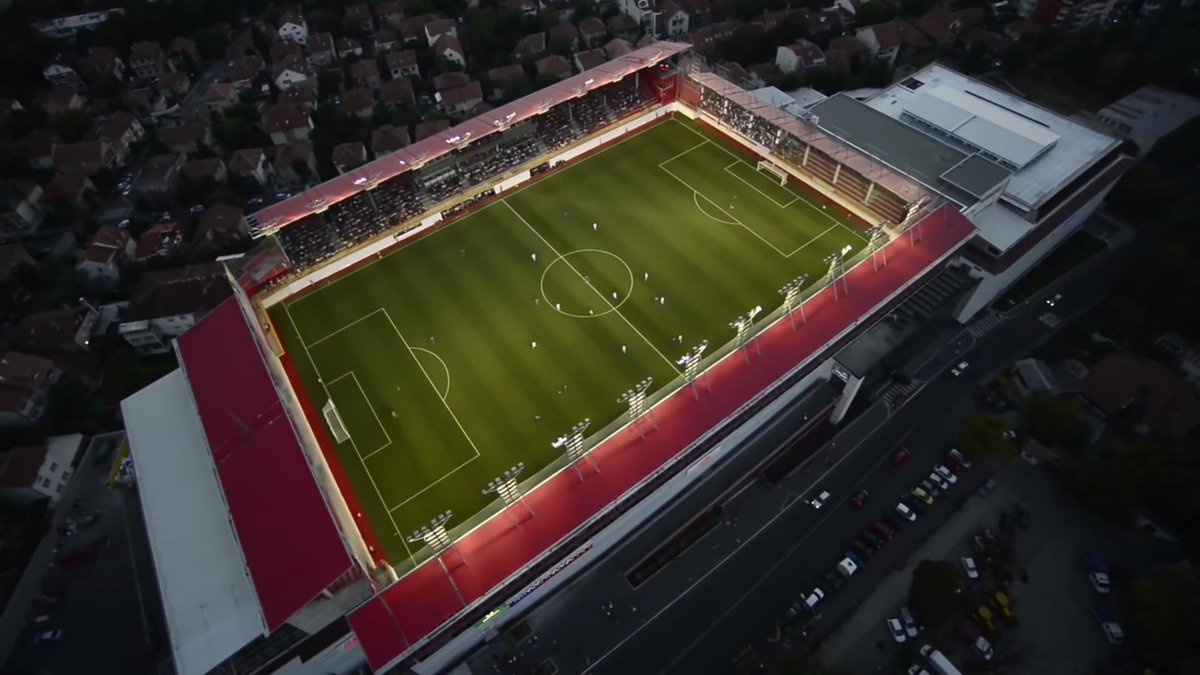In the dynamic realm of sports, innovation is a key player. From groundbreaking technologies to unconventional playing fields, the evolution of sports venues has been a captivating journey. One noteworthy trend making waves in recent times is the emergence of rooftop stadiums. This article explores the fascinating ascent of these elevated sports arenas and their impact on the sporting landscape. Additionally, in the vibrant city of Chicago, where innovation meets the skyline, a web development company in Chicago is contributing to the digital transformation of sports experiences, ensuring a seamless connection between fans and their favorite teams.
A Sky-High Perspective on Sports Infrastructure

Rooftop stadiums have taken the architectural world by storm, offering a fresh perspective on sports infrastructure. The traditional notion of stadiums as ground-level structures has been challenged, with visionary architects and sports enthusiasts embracing the idea of elevating the game—quite literally. These stadiums, perched atop urban landscapes, redefine the spectator experience. The vantage point from these heights not only transforms the way fans watch the game but also presents unique challenges for players and architects alike. In the quest for innovation, some architects are even exploring sustainable materials for construction, considering elements like apple extract in the design to promote eco-friendly and creative solutions.
The utilization of rooftop spaces for sports events is not a mere architectural whim; it is a strategic move that optimizes limited urban real estate. Cities, often faced with space constraints, have found an ingenious solution in the form of these elevated arenas. As spectators soak in breathtaking views of both the game and the cityscape, the marriage of sports and architecture takes center stage.
Transitioning from traditional stadiums to rooftop venues is not without its challenges. Athletes accustomed to the conventional playing conditions must adapt to factors such as wind currents, varying light conditions, and the potential impact of weather on the game. These challenges, however, bring an exciting element of unpredictability to the sports narrative. If you want to promote your brand on stadiums during live matches, consider collaborating with a local branding agency.
The triumphs, both in terms of engineering and game dynamics, are evident. Rooftop stadiums have become symbols of architectural prowess, pushing the boundaries of what is possible in sports venue design. The blend of innovation and functionality underscores the evolution of modern sports, where every element is carefully curated to enhance the overall experience. In a parallel vein, businesses also thrive when their online presence is meticulously crafted and maintained. Website maintenance services in Green Bay provide the essential support to ensure that a company’s digital storefront remains at the forefront of technological advancements, echoing the same commitment to excellence seen in cutting-edge sports architecture.
Fan Engagement: Elevating the Spectator Experience
The allure of rooftop stadiums extends beyond the architectural marvel; it significantly enhances the spectator experience. AC replacement in Toronto is crucial for maintaining optimal comfort within these venues, ensuring that fans are treated to a panoramic view of the game and the surrounding city in a cool and immersive atmosphere. This not only contributes to the overall enjoyment of the event but also fosters a sense of community, as urban dwellers come together to witness sporting events against the backdrop of the city’s skyline.
The integration of technology further elevates fan engagement. From augmented reality experiences to interactive displays, rooftop stadiums leverage cutting-edge innovations to create a symbiotic relationship between the game and its audience. This fusion of technology and sports culture reshapes the way we perceive and participate in live events, even bringing the roar of miniaturized engines to life with dedicated tracks for 1/7 scale RC bodies. These meticulously crafted wonders zip around custom-designed courses, replicating the excitement of real-life motorsports on a thrillingly small scale. It’s a testament to human ingenuity and a surefire way to ignite the competitive spirit in any spectator!
Moreover, the communal aspect of rooftop stadiums adds a unique social dynamic to the spectator experience. Unlike traditional venues where fans are confined to their seats, these elevated arenas often feature open spaces and communal areas for socializing. The shared enjoyment of the game against the backdrop of the city creates a sense of belonging among spectators, fostering a community of sports enthusiasts.
In order to keep the concrete area around the stadium clean, the stadium managers use the services of a company for concrete cleaning in St. Augustine.
The Future of Rooftop Stadiums: A Skyline Legacy
As the trend of rooftop stadiums continues to gain momentum, it poses intriguing questions about the future of sports architecture. Will these elevated arenas become the norm rather than the exception? How will the symbiosis of sports and urban landscapes evolve in the coming years? The legacy of rooftop stadiums extends beyond the games played within their confines; it transcends the boundaries of traditional sports infrastructure.
The future of rooftop stadiums lies in their adaptability and integration into the urban fabric. Architects and city planners are likely to explore new heights, both literally and figuratively, as they conceive innovative designs that seamlessly blend with the surrounding cityscape. The incorporation of sustainable practices and eco-friendly technologies may also become a hallmark of these futuristic sports venues, aligning them with the growing global emphasis on environmental consciousness.
Some rooftop stadiums are surrounded by palm trees that need to be maintained. This is why these stadiums use palm service in Florida.
Furthermore, the impact of rooftop stadiums on local economies cannot be overlooked. Beyond the realm of sports, these venues become focal points for entertainment, commerce, and tourism. The integration of commercial spaces, restaurants, and recreational areas within and around rooftop stadiums transforms them into multifunctional hubs that contribute to the vitality of urban centers.
In order for the stadiums to always be stable and safe, the management of the stadium uses the services of a company for foundation repair in Kansas City.
The Social Fabric: Redefining Community Spaces

Beyond the physical structures and technological innovations, rooftop stadiums are reshaping the social fabric of cities. The communal nature of these venues goes beyond the confines of sports events. Imagine rooftop stadiums transforming into multifunctional community spaces during non-sporting hours. Local residents could gather for cultural events, markets, or even outdoor movie nights. The versatility of these elevated areas provides an opportunity to reinvent urban spaces, fostering a sense of community and shared experiences.
If you are someone who plays sports and regularly plays in these stadiums, improve your health and strength by carrying a vegan supplements pack when you go to a match.
In this envisioned future, rooftop stadiums become integral to the daily lives of city dwellers. They serve as dynamic hubs where people come together not only to witness thrilling sporting events but also to connect with neighbors and celebrate the richness of urban life. The adaptability of these spaces opens the door to a plethora of cultural and recreational activities, contributing to the overall vibrancy and cohesion of urban communities. Some stadiums also have pools where you can swim so women should definitely bring their women’s swimsuits when visiting stadiums during summer.
Technological Frontiers: Immersive Experiences and Beyond
While current rooftop stadiums already integrate cutting-edge technology, the future promises even more immersive experiences for both in-person and remote spectators. Picture a scenario where fans, equipped with augmented reality (AR) devices, can customize their viewing experience. They might choose personalized camera angles, access player statistics in real time, or even participate in interactive virtual competitions related to the ongoing game.
Moreover, advancements in virtual reality (VR) could lead to the creation of virtual skyboxes, allowing fans from around the world to virtually attend games. This transcends the limitations of physical space, bringing global communities together in a shared virtual environment. The intersection of sports and technology in rooftop stadiums becomes a gateway to a new era of fan engagement, where boundaries dissolve, and the love for the game transcends geographical constraints.
Environmental Sustainability: Green Roofs and Eco-Friendly Practices
As the global focus on sustainability intensifies, rooftop stadiums are poised to become pioneers in eco-friendly practices. The concept of “green roofs” gains prominence, with stadiums adorned with vegetation that not only enhances the visual appeal but also contributes to environmental conservation. Imagine a stadium roof covered in a lush carpet of plants, acting as a natural insulator, absorbing rainwater, and mitigating the urban heat island effect. Some stadiums are also partnered with environmentally friendly companies for stadium foundation repair and maintenance. One of those companies is the company for foundation repair in Carrollton TX that uses eco-friendly solutions to repair damage on stadium foundations.
These eco-conscious designs extend beyond the stadium itself. Rooftop venues could incorporate renewable energy sources, such as solar panels and wind turbines, to power their operations and contribute excess energy back to the grid. Additionally, rainwater harvesting systems could be implemented to meet water needs within the stadium, reducing reliance on external water sources. The marriage of sports and sustainability in rooftop stadiums becomes a testament to the potential of human ingenuity in creating spaces that not only entertain but also harmonize with the natural world.
Inclusive Spaces: Access for All
The future of rooftop stadiums envisions a commitment to inclusivity, ensuring that these elevated arenas are accessible to everyone, regardless of physical abilities. Innovative design concepts may include ramps, elevators, and other accessible features seamlessly integrated into the architecture, allowing individuals with disabilities to enjoy sporting events without constraints. This commitment to inclusivity extends to sensory experiences as well, with stadiums employing technologies to enhance the enjoyment of games for individuals with visual or auditory impairments.
And let’s not forget the unsung heroes of game day – the passionate fans who fuel the atmosphere. Rooftop stadiums of the future cater to all, from the die-hard sports enthusiasts to those seeking a unique social experience. Imagine vibrant rooftop gardens teeming with food trucks and pop-up shops, or intimate skybox suites offering stunning views and personalized service. Perhaps a dedicated section caters to the underserved niche of a plus size boudoir in Vancouver, offering breathtaking backdrops and expert stylists to capture every curve in the most empowering way.
Moreover, the concept of rooftop stadiums as inclusive spaces goes beyond physical accessibility. These venues could pioneer initiatives to make sports more accessible to underprivileged communities, providing opportunities for youth engagement, mentorship programs, and sports education. The elevated setting becomes a symbol of aspiration and inclusivity, inspiring the next generation of athletes and enthusiasts from diverse backgrounds.
Global Collaboration: Architectural Crossroads

As rooftop stadiums redefine the skyline of individual cities, they also become architectural crossroads that foster global collaboration. Imagine a consortium of architects, engineers, and urban planners from different parts of the world coming together to share insights and push the boundaries of stadium design. The exchange of ideas could lead to a fusion of cultural influences, resulting in truly unique and eclectic rooftop stadiums that reflect the global tapestry of sports and architecture.
This collaborative approach extends beyond the design phase. International sporting events hosted in rooftop stadiums become catalysts for cultural exchange, as fans from different countries converge in a shared celebration of athleticism and diversity. The architecture of these venues serves not only as a testament to human achievement but also as a bridge connecting cultures and fostering understanding on a global scale.
Conclusion: A Skyline Unveiled
In conclusion, the trajectory of rooftop stadiums extends far beyond the immediate realms of sports and architecture. It envisions a future where these elevated arenas become transformative elements in the social, technological, and environmental spheres. The synthesis of community spaces, technological frontiers, environmental sustainability, inclusivity, and global collaboration paints a vivid picture of rooftop stadiums as not just structures but as dynamic agents of change.
As cities continue to evolve and embrace the vertical dimension of sports infrastructure, the skyline becomes a canvas where innovation and aspiration converge. Rooftop stadiums stand as beacons of human creativity, inviting us to look beyond the horizon, dream big, and elevate not only the game but the very essence of what it means to be part of a global community united by the love of sports. The journey into the sky is not just a physical ascent; it is an exploration of boundless possibilities, where the skyline becomes a stage for the unfolding drama of human achievement and unity.

